
|
|
Abstract: Five unrelated items: "The Philippines: Catholic Priests Detained and Murdered," "Two Halves Are Better Than One," "Vision Quest," "Emerging From...", and a Pogo comic mentioning Bahá'í Naw Ruz. Notes: The following essays are not related and were not published in the same issues, but are included together for ease of filing and because they were not long enough to warrant posting as separate items. See also list of dialogue articles or image scans. |
Various essays
by Carol R. Goodrich, Rob Leavitt, David Langness, and Larry Doyle
published in dialogue1986-1988
The Philippines: Catholic Priests Detained and Murdered
Dialogue Vol. 1, No. 1, pp. 31-32 (1986)
A campaign of terror is being waged against the Philippine religious community. In the past year at least six clergymen and more than a dozen journalists have been killed, apparently by military or paramilitary forces. The government blames the killings on the leftist New People’s Army, but that claim defies belief. The victims, all of whom were active in human rights work and helping the poor, were critics of the Marcos regime, not the N.P.A. Moreover, clergy and laity who have protested the killings have been threatened.
Among the murdered or missing clergymen:
- Father Tullio Favali, an Italian missionary affiliated with the Pontifical Institute for Foreign Missions. On April 11, in Esperanza, members of the government’s Integrated Civilian Home Defense Forces set fire to Favali’s motorcycle and then shot him twenty-two times. The priest was visiting the home of a person wounded by this paramilitary group.
- Father Alberto Romero. He was gunned down May 17 in Silawe, Polanco, by three unidentified men who barged into a chapel where he had been blessing religious icons. The government attributed his murder to the N.P.A.
- Father Rosalio (Rucy) Romano, a human rights advocate who was recently elected to the National Council of Bayan, a broad-based nationalist organization. He was last seen on July 11, being forced into a car with government license plates by men in civilian clothes carrying M-16s.
Father Teodoro Remigio, aged 40 and a parish priest in Ilocos Norte in the north west Luzon island, was arrested early on 30 March 1985, immediately after saying Mass at a parish church in Piddig, near Laoag City. He was charged the same day with rebellion, and a court in Laoag City recommended bail of 14,000 pesos (about US$ 750). While the Bishop of Laoag, Edmundo Abaya, was able to raise the necessary bail money, Fr. Remigio was flown by military helicopter to the Regional Unified Command (Region 1) Headquarters at Camp Dangwa, La Trinidad, Benguet. There he was shown a copy of a Preventive Detention Action (PDA) signed by President Marcos on 28 March, which authorized his continued detention despite the court’s recommendation of bail. According to one lawyer this PDA had not been properly filled out, but Amnesty International has no further details on this matter. The PDA is a detention order, signed by the President, which authorizes the detention of suspects on grounds of national security for renewable periods of one year.
The military authorities were reported by the official Philippine News Agency (PNA) to have accused Fr. Remigio of involvement in the New People’s Army (NPA⎯the armed wing of the Communist Party of the Philippines), which is particularly active in the Mountains of northern Luzon. Specifically they accused him of being a friend of the former priest Conrado Balweg, who joined the NPA in 1979 and who is now one of its best known leaders. According to the PNA report, the Mayor of Dumalneg, Lorenzo Santos, had complained to the military authorities that Fr. Remigio had been named by three suspected subversives in prison there as a recruiter for the NPA, and that he had been organizing communist cells in the Dumalneg area.
Unnamed military officials were also quoted by the PNA report as saying that Fr. Remigio has “openly criticized” the government of President Marcos. On 1 April, however, Fr. Remigio told reporters that all the charges against him were lies: “It is unfortunate that all my activities, which were actually approved by my superior, Bishop Edmundo Abaya, had been interpreted as anti-government and subversive.” He further denied the accusation that he was a friend of Conrado Balweg saying, “I have never met Father Balweg in my whole 40 years.”
Father Remigio had been active in human rights work in the Ilocos region. In 1979 he had been appointed as coordinator for the Episcopal Commission on Tribal Filipinos ⎯ a church based group which supports indigenous tribal Filipinos in the fields of cultural preservation, land and economic disputes, education and human rights ⎯ in Laoag City. He had taken part in a fact-finding mission as coordinator for Laoag City for the nationwide church-sponsored human rights organization, the Task Force Detainees (TFD). During 1984 he was reported to have been active in the campaign to boycott the parliamentary elections which took place in May 1984, and to have worked actively for the release of the political detainee Lenville Salvador in prison in Laoag City.
Father Remigio is reported to be currently detained in the quarters of the military chaplain at the Regional Unified Command (Region 1), Camp Dangwa, La Trinidad, Benget.
Amnesty International is concerned that Father Remigio may have been detained for his activities in church-sponsored human rights organizations in the Laoag City area. It is therefore taking up his case to investigate the background to his arrest and to determine whether he has been detailed for the non-violent expression of his beliefs.
Please write courteously worded letters giving a brief description of the prisoner’s case, expressing concern that he has been detained for non-violent activities in church-based based rights organizations, and urging the authorities to do everything in their power to ensure that he receives a fair trial, and that his case is speedily resolved.
WRITE TO:
- General Barangan
Chief Presidential Security Command
Malacanang Palace
Metro Manila, Philippines
Two Halves Are Better Than One
By Carol R. Goodrich, in Dialogue Vol. 1, No 4, p. 46 (1986)
I am a 41-year-old adolescent suffering from adulthood. I didn’t know what to call my problem until I read several fascinating stories about split personality. Psychology is wonderful because it gives names to the problems we always suspect we might have. It isn’t easy accepting the fact that two distinct personalities are sharing my body. Even though I know this is a genuine handicap, my local grocery store refuses to give me special parking privileges.
Today I am sitting in my living room, surrounded by a really magnificent library of awesome ideas, eternal truths, self-help manuals, and concrete facts. And what am I doing? Flipping through a comic book, smoking a cigarette, and craving excitement. My emotional self feels unfulfilled. It also feels guilty. It spends most of its time trying to find how many circus animals are hiding in every picture of uniformity. It is always asking, “Is this a trick question?” The other day it shredded a perfectly good copy of The American Baha’i with the excuse of recycling uplifting information into Very Important Confetti.
On the other side the room sits my intellect. I resent the fact that she is trying to use my life to advance herself. This morning she has chosen the window and looks stunningly opaque. The sound of harp tones tells me she is once again plucking the strings of reverie. I swallow the impulse to make an awful noise. Her presence this early in the day somehow always puts me on the edge of the back seat of a slow-moving Edsel winding its way through a safe and scenic countryside. See the cows? See the farmhouse? See the green pastures? I don’t bother pointing out this is a boring drive, and that the only way I want to understand a cow is through a hamburger. I don’t dare suggest a detour towards city lights. Fortunately, technology has afforded me a device to use in co-existing with my elder self: earphones. My eyes shut, I listen to Tina Turner. Intellect is so preoccupied with her observations, she doesn’t even notice how I can sit and dance at the same time.
Gossamer has never been my style. I feel ambiguity has given me plaid intelligence. Conflicting desires produce interesting patterns. So I dress in perplexities. Although I have added a few definitive touches. For instance, this morning I woke up craving the idea of blue hair. I also had the uncanny desire to dye my tennis shoes lime green. But after spending awhile rummaging under my dresser, I discovered I didn’t own any tennis shoes. This was traumatic enough to provoke me into spray painting my favorite sweatshirt.
My intellect copes with my dilemmas with the same dexterity she uses in brushing aside a bothersome fly. She has mastered certain meditative techniques to drown out the annoying sounds of the commonplace. I personally suspect she is upset about having to do “time-out” on this planet. But sometimes it is hard for me to be compassionate about her disinterest. She may feel it is worth her time to look for the hidden snaps that will let her detach from this mudslide; I feel it is a waste of energy.
So I sit toying with the idea of gluing on the false fingernails I bought the other day and using them to rent her translucence. She doesn’t wear it as well as she thinks. But who am I to accuse her of vanity? This bad thought and the fact that my spray painting didn’t even come close to the effect I was trying to achieve, plus the fact that I am doomed to spend another entire day with no one to help me play, provokes a caustic remark: “You wanna know something,” I say, standing in front of her reverie. She slowly turns from an engaging thought.
“Yes,” she answers.
“I don’t like you.”
“You know what your problem is?” she ventures, in a kind and patient tone. “You are suffering from what I am beginning to think is an incurable immaturity. You are not yet whole. You are not in tune with the Infinite. You are....”
“Sorry about that,” I say, wiping up the coffee I have just poured on her lily-white, glass slippers. “I am also very clumsy.”
It is going on evening and I have been in my bedroom all afternoon. Intellect is still at her window seat discovering some wonderful significance in the fall of evening shadows from the boughs of supernal trees. I am dreading the fact that she will distill this into a quintessence of useful truth and serve it up for dinner. A diet of essences doesn’t satisfy my hunger. I decide on another plan. It is, after all, a full moon night. I open my bedroom window and quietly sneak out. I have planned ahead this time. My knapsack contains some bread, some cheese, and a book of radical poems. Did you know that blue hair is absolutely striking in moonlight? I will scratch my name on tree bark. I will run through the grass with my bare feet. I will bathe in the midnight winds. But I will suppress my urge to howl until this house is out of sight. She would never understand my approach to prayer.
Carol Goodrich lives in Bellingham, Washington, where she pursues life’s deeper meanings while editing the Cosmic Glue Review.
Vision Quest
By Rob Leavitt, in Dialogue Vol. 2, No. 1, pp. 45-6 (1987)
On June 20-21, 1987, 42 leading national and local disarmament activists converged on Ringwood, New Jersey, to discuss the requirements and the plausibility of a long-term, unified campaign to eliminate all nuclear weapons worldwide. The gathering was an extraordinary example of the new efforts with the U.S. peace movement to develop a more sophisticated and compelling framework for public education and political action.
There were few formal presentations at the Ringwood conference. Neither was there much discussion of organizing tactics, political crises, or immediate priorities. Instead, the two days of discussion focused on the overarching question: What changes are required in the U.S. peace movement, in U.S. politics and society, and in the world to achieve nuclear disarmament?
The conference was organized by staff members of many leading national peace organizations, including American Friends Service Committee (AFSC), Clergy and Laity Concerned, the Institute for Defense and Disarmament Studies (IDDS), Mobilization for Survival, Peace and Solidarity Alliance, SANE/Freeze, War Resisters league, Women’s International League for Peace and Freedom, and the U.S. Peace Council. Participants represented more than two dozen local and national groups.
At the end of the weekend, the conclusions of the group were dramatic. The initial impetus for the conference was a “Disarmament 2000” campaign proposal developed last winter by Mobilization for Survival. That proposal focused primarily on nuclear weapons, and on the mass movement necessary to abolish nuclear weapons by the year 2000. But after spending two days debating this proposal and a broader “Disarmament 2000 — Common Security” campaign submitted by AFSC’s Bruce Birchard, a consensus emerged on two central propositions.
First, it is difficult to imagine that total nuclear disarmament is possible in the absence of a new world order characterized by international principles of “common security” for all peoples and nations.
Second, a world without nuclear weapons, and with common security would necessarily entail significant progress in at least five areas: (1) the ending of military intervention by nations in the affairs of other nations; (2) the achievement of general and complete disarmament of conventional, as well as, nuclear weapons; (3) the dedication of resources currently devoted to military purposes toward economic reconstruction of the U.S. and appropriate economic development within the Third World; (4) international support of human rights; and (5) strengthening of existing, and creation of new, international institutions and mechanisms for peacekeeping.
According to the group, a successful long-term campaign to achieve nuclear disarmament must necessarily define itself in these terms, and develop a strategy that addresses all of these issues in an overall vision of a nuclear free, common security world. Given the immensity of such a project, there was little consensus that nuclear disarmament by 2000 was possible.
After the conference, a small ad hoc follow-up committee began work on a conference report and a draft manifesto which will outline the principles and goals of a disarmament/common security formulation. “It’s still a fragile process,” said Glenn Gersemehl, co-chair of the Gray Panthers’ peace task force, “but what’s so exciting is the possibility of providing a framework for the grassroots, where all see a real enthusiasm for this kind of visionary approach.”
“Visionary” thinking is very much apparent in the peace movement today. As Pam Solo, co-director of the Institute for Peace and International Security (IPIS) in Cambridge, Massachusetts, puts it, “The search for a ‘peace politics,’ an intellectual and moral framework” to undergird an alternative security system, is creating a new “cottage industry.”
Solo’s own IPIS is one of the new organizations working on alternative security definitions and policies. Last January IPIS sponsored a major conference, bringing together activists and academics from 40 states, Western Europe, and New Zealand to “talk about a range of issues not as a shopping list, but as specific parts of the overall problem of militarism and war.” According to Solo, the peace movement needs “to develop a more robust, enduring framework that won’t get fractured the way freeze was.”
Another new program comes from the Washington DC—based Institute for Policy Studies (IPS). According to IPS Senior Fellow Richard Barnet, the “four pillars” of post World War II national security policy — nuclear deterrence, military alliances, Third World interventionism, and global free trade — are increasingly untenable. The IPS Real Security education Program is oriented to the development and promotion of a “new Conceptual framework” for thinking about U.S. security.
Other progressive think tanks and national organizations that have embarked on similar alternative projects are the World Policy Institute and Alternative Defense Project in New York, the Boston-based Exploratory Project for the Conditions of Peace, the Coalition for a New Foreign Policy, and the Institute for Security and Cooperation in Outer Space in Washington DC, the Peace and Environmental Project in San Francisco, and the new Institute for Global Security Studies in Seattle. The Institute for Defense and Disarmament Studies has initiated a wide-ranging Alternative Defense Project with different components addressing arms control experts, the media, and grassroots activists.
The surge of national conferences and projects exploring alternative security and defense suggests that the peace movement is struggling towards a new understanding of the issues of war and peace. Yet, the real value of this new paradigm as an organizing framework must be tested at the grassroots.
Indeed, local groups are beginning to find ways to integrate these new concepts with their day-to-day peace work. For instance, Sixth Sense in Tacoma, Washington has developed an umbrella structure to support a variety of both “traditional” protest and lobbying activities and new alternative security projects. Peace Associates in upstate New York has created a Global Security project, and begun a series of “consultations” in coordination with Global Education Associates to explore new local education programs to promote global security concepts. And in May 1987, the New York City office of the AFSC kicked-off a new “common security” project with a major conference.
As the peace movement discussion of alternative security and defense matures, it should focus increasingly on defining the relation between long-range vision and the on-going activity and campaigns of both local and national peace groups. Defining this relation is our next challenge, and meeting this challenge is key to rooting the new paradigm in popular consciousness.
Rob Leavitt of Boston, Massachusetts is coordinator of the Alternative Defense Network, a grassroots education project of the Institute of Defense and Disarmament Studies. This article is reprinted from Defense and Disarmament News, the bimonthly publication of IDDS.
Emerging From... ["The Back Page"]
Dialogue Vol. 2, Nos. 2 & 3, p. 63 (1988)
Literature
They had not planned on having to counsel with a preacher. They no longer believed in the formalities of the faiths they were brought up in, if in the faiths themselves, and neither of them had been in a church for years, but they felt uneasy about a marriage ceremony in a courthouse or office or kitchen, conducted by a judge or justice of the peace. “That’s so gross and public,” was her opinion. “Too slam bang,” he said. So while they waited for their blood specimens to be evaluated by the state, he began making phone calls from the motel room they’d taken in Madison. First he tried the nondenominational chapels, the congregational churches, the quasi-religious brotherhoods; few of them answered their phones, and most that did sounded suspicious of him. Others sounded suspicious to him. Finally he reached a certain number and talked happily for a few minutes, and then in morose monosyllables for a long time. He hung up.
“The Bahá'ís are out,” he said.
“What’s that?” She was in the bathroom.
“No go with the Bahá'ís.”
“How come?”
“You need signed certificates from the family of each participant and the council, whatever that is, only convenes once a month. They just met yesterday.”
- What I’m Going to Do, I Think,
Farrar, Strauss, Giroux, a novel by L. Woiwode
At Bahá'í weddings, confusion on the part of those new to the Faith can take on a dimension of hilarity.
One Bahá'í couple, nervous for all the usual reasons on their wedding day, were doubly worried because the groom’s Jewish parents knew nothing about the Faith. As his very traditional mother and father arrived late at the Bahá'í home where the ceremony was to be held, the groom hurriedly told them that the nuptials might be somewhat unorthodox, but that he would explain afterwards, and rushed off to his bride’s side. They stood, surrounded by their casually-dressed young friends and two older and more formal representatives of the local spiritual assembly who were serving as witnesses. One witness, the stern and somewhat officious chairman of the assembly and a local livestock inspector for the Agricultural Department, made the introductions and said a short prayer. Two more prayers were read, the couple recited their vows, and the wedding was over in a scant few minutes.
The parents, confusion and perplexity evident on their faces, were obviously unsure their son was now married. Approaching the LSA chairman, the mother asked in a furtive whisper, “Excuse me — are you the minister?”
“Lady,” he replied in a voice so loud it was heard throughout the room, “I’m no minister — I’m a cattle checker!”
Contributed by David Langness

The popular, nationally syndicated Pogo comic strip celebrated Naw Ruz this year in "Heighdy High!" fashion. Larry Doyle, the strip's writer, informed dialogue that he wanted to help celebrate the spring equinox of 1989 with bang. Doyle learned about the faith through visiting the Bahá'í House of Worship in Wilmette, and says he thought the Bahá'í new year (Naw Ruz) celebration was a good way to kick off the March 21st strip.
| The Philippines: Catholic Priests Detained and Murdered, in dialogue 1:1, pp. 31-32 (1986) |
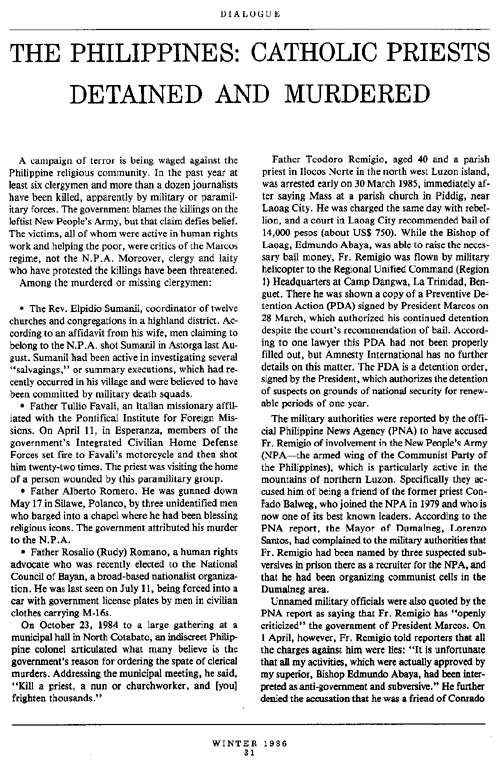 click for larger image |
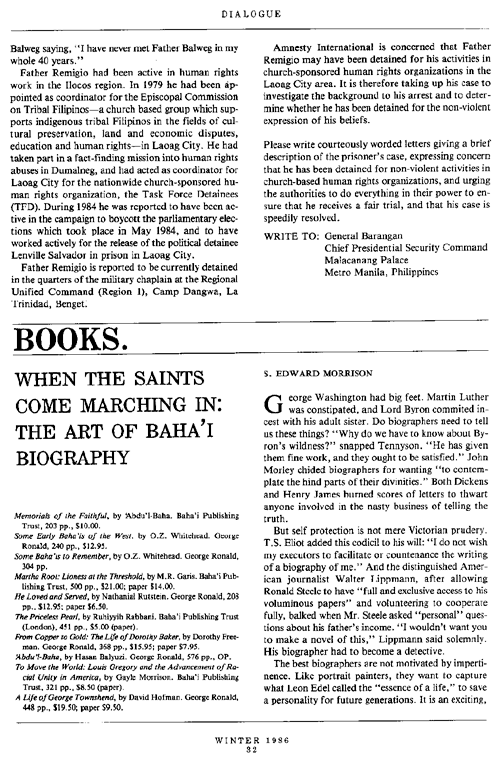 click for larger image |
Two Halves Are Better Than One, in dialogue 1:4, p. 46 (1987) |
 click for larger image |
"Vision Quest," in dialogue 2:1, pp. 45-46 (1987) |
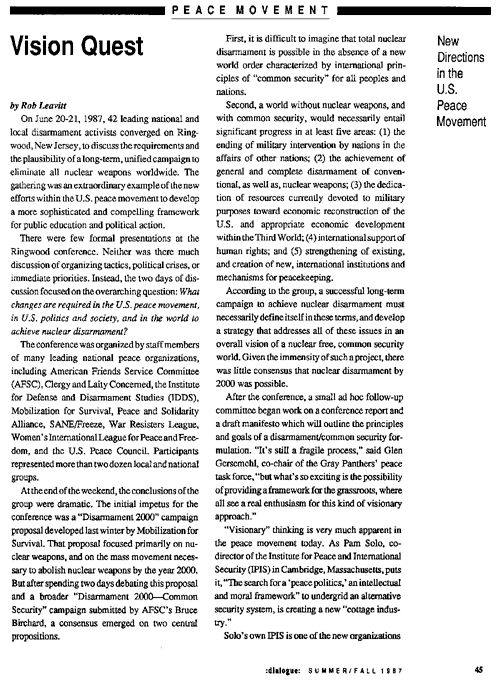 click for larger image |
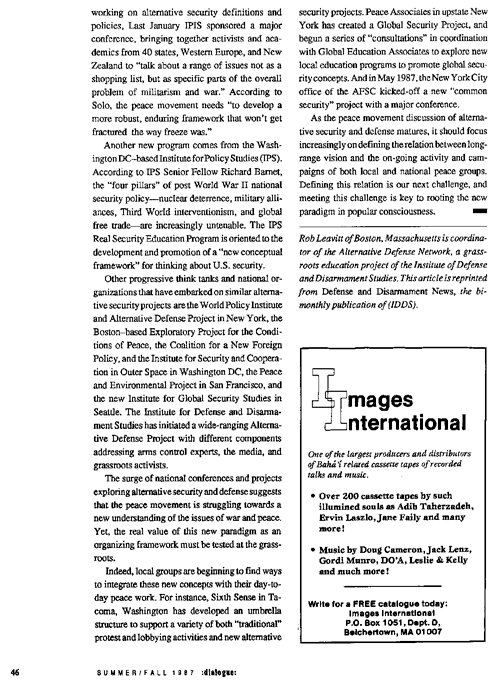 click for larger image |
"Emerging From...," in dialogue 2:2-3, p. 63 (1988) |
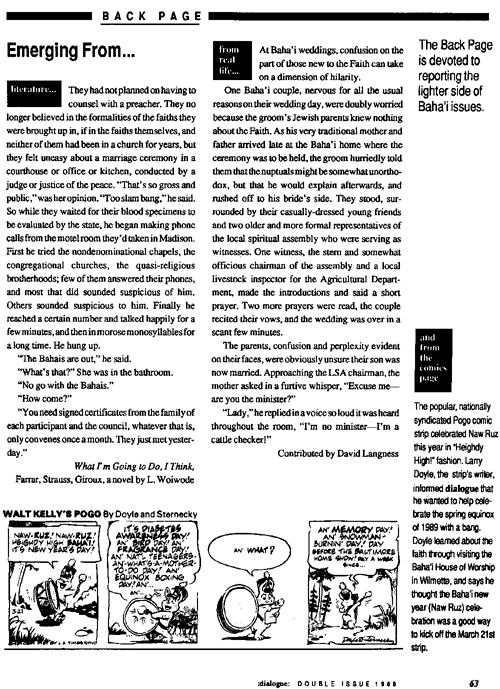 click for larger image |
|
|